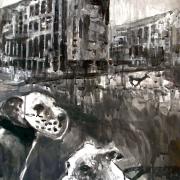
Some people are shocked at first, even repelled, by Norrie Harman’s no-holds-barred vision of real life in Way Out West, showing this month in the Union Gallery.
It is an understandable reaction – after all, the works displayed are full-on depictions of hard times and tough realities lived beyond the comfortable confines of Edinburgh’s orderly heart. Mostly rendered in India ink and watercolour shades of black, grey and white, they are unflinchingly honest, unsettling, and occasionally horrific. The fluids drip towards the bottom of the paintings – there is a pervading sense of decay, of blood and tears, and chronic spillage.
And yet … and yet, the longer you look, the more you dwell, the more humane and intriguingly nuanced these hellish visions become.
Norrie Harman grew up in Wester Hailes amid the vivid and often violent foreground of a society brutalised by poverty. Gang culture, drug and alcohol abuse, and an architectural scheme of uncompromising ugliness were his everyday realities.
But from an early age, he says, he also admired the backdrop of the Pentland Hills: that alternative, shifting theatre of land and sky which could not be ignored, whose living cast kept leaking into his dystopic now.
There are no strict, measurable, causes and effects here, but that physical – and by extension moral, emotional and intellectual – permeability seems crucial to Harman’s sense of the past and his re-creation of its space and culture. Rather than relentless gloom, his apparently unflinching certainties are frequently suffused with irony, paradox, ambivalence, and surprising gentleness.
Take ‘The Hunt’, for example (top-right), in which two dogs (one muzzled) strain to be unleashed in pursuit of the stag crossing their estate. The painting’s subject matter is a modern, qualified twist on a traditional scene, and in that reference has some canonical wit. But it also raises deeper questions about the cruelty of animal instinct, and the common threads of humanity expressed in social pursuits across historical and class divides.
Harman clearly loves the wildlife of Wester Hailes, empathising with its unapologetic fierceness, fear and vulnerability. But there is characteristic tragedy in the way his truest, tenderest portrayals of it are only possible in destruction: ‘Dead Deer’ (below) is a beautifully observed study and one of the highlights of the show. (It is extraordinary to consider, by the way, that in using the notoriously unforgiving medium of India ink, Harman will use anything but brushes.)
[img_assist|nid=3087|title=|desc=|link=node|align=middle|width=640|height=470]
Not all his creatures are so endearing. In ‘Festival’, a baboon sits above the chaotic ruin of the summer capital. In ‘Feral’ (below), a hyena emerges from the succession of background power station and mid-ground caravan. Again, the creature is wonderfully well painted – squat, menacing, but strangely wistful. And in its associations with ruthless violence and uncanny ‘laughter’, it also links to perhaps the most disturbing of Harman’s recurrent figures: the clown.
[img_assist|nid=3088|title=|desc=|link=node|align=middle|width=477|height=640]
There is no escaping ‘Hilary’s for Tea’ (below) – an enormous oil painting, and the only one here in colour. It hangs at the back of the gallery and demands one's attention. A somewhat disconsolate, transvestite or aproned clown confronts the viewer, his face grotesquely made up, the lips either torn away to reveal teeth beneath or elaborately decorated to achieve the same effect as part of some gruesome carnival disguise. Beside the figure is a table on which rests a severed pig head. Table and clown are spattered with gouts of colour.
The title of the work is, I’m sure, deliberately funny and disconcerting. The Hilary in question perhaps reflects Harman’s sense of being an artist – with contradictory elements of self-concealment and exhibition, the potential for laughter and harm, a ritualised abnormality. Perhaps the pig’s head, and the messy slaughter which preceded it, are somehow Harman’s artistic project.
[img_assist|nid=3089|title=|desc=|link=node|align=none|width=640|height=640]
Interestingly, he is the son of a butcher, and describes another painting here – ‘Hanging Meat’ – as a homage to his father. Harman’s father, he says, sees not a carcass, but a potential wealth of alternatively sized and shaped cuts: violence and thoughtfulness combined, as in a sculptor assessing an untouched block of stone.
If Harman's wordplay in the titles of his works is sometimes darkly amusing ('Torness Icecream' is a particularly excruciating tip of the hat to Edvard Munch), it can also be more serious. The blank expression of a substance abuser is the subject of 'Glue' (below). Glue is a substance which binds; and yet this portrait is about abstraction, social, mental and emotional dislocation. The young woman we observe is simultaneously ruined, lost, vulnerable and attractive. Harman's gaze pulls her apart and holds her together – it is an astonishing feat and, to my mind, probably the most impressive painting here.
[img_assist|nid=3091|title=|desc=|link=node|align=none|width=478|height=640]
Way Out West is not an exhibition to send you bouncing home with a spring in your step and a song in your heart. It is hard work in the best sense, challenging in a good way, bravely staged and highly rewarding. I recommend it. AM
[Way Out West will show at the Union Gallery, 45 Broughton Street, until 3 July.]